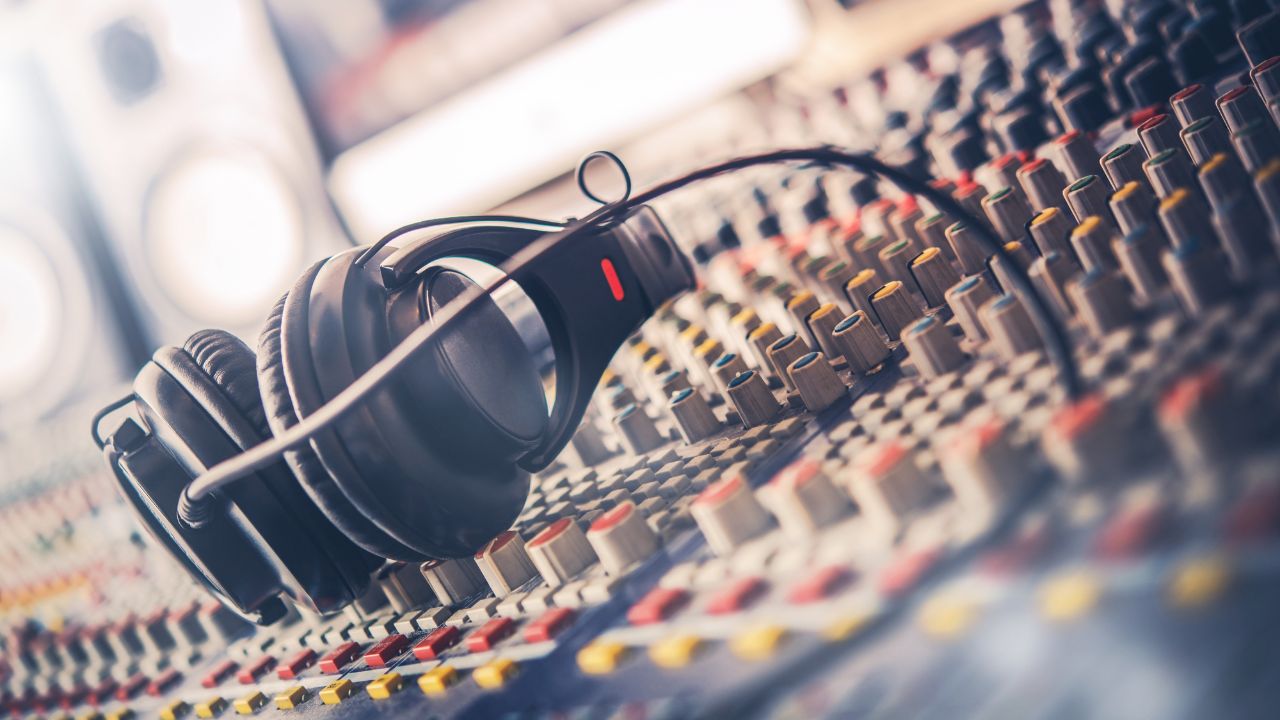Key Concepts of Mastering:
Mastering involves several essential concepts and techniques that contribute to achieving a polished and professional sound. Here's an overview of the key concepts:
- EQ (Equalization):
- EQ is used to adjust the frequency balance of a track by boosting or cutting specific frequencies.
- It helps balance the tonal characteristics of the music, enhance clarity, and remove any unwanted resonances or frequencies.
- Compression:
- Compression is used to control the dynamic range of a track by reducing the volume of louder sounds and boosting quieter ones.
- It helps to even out the overall volume of the music, increase perceived loudness, and improve the track's presence and punch.
- Stereo Imaging:
- Stereo imaging refers to the spatial placement and width of the audio signals within the stereo field.
- Techniques such as panning, stereo enhancement, and stereo width adjustment are used to create a sense of depth and space in the music, enhancing the listening experience.
- Loudness Normalization:
- Loudness normalization ensures that the volume level of a track is consistent with other tracks in a playlist or album.
- It involves adjusting the overall loudness of the music to meet specific loudness standards, such as LUFS (Loudness Units Full Scale), to prevent sudden volume jumps between tracks.
Each of these mastering concepts plays a crucial role in shaping the final sonic characteristics of a track. By understanding and applying these techniques effectively, aspiring artists can achieve a balanced, cohesive, and professional sound that captivates listeners on SoundCloud and beyond.

Setting Up Your SoundCloud Studio:
Setting up a home studio environment for mastering music is essential for aspiring artists looking to achieve professional results. Here's a guide on how to get started:
- Choose the Right Space:
- Select a quiet and acoustically treated room for your studio space to minimize external noise and reflections that could affect your listening environment.
- Essential Equipment:
- Digital Audio Workstation (DAW): Choose a DAW software that suits your workflow preferences and budget. Popular options include Ableton Live, Logic Pro, Pro Tools, and FL Studio.
- Studio Monitors: Invest in a pair of high-quality studio monitors for accurate playback and monitoring of your music. Look for monitors with a flat frequency response for reliable mixing and mastering.
- Audio Interface: A good quality audio interface is essential for connecting your studio monitors and other audio equipment to your computer. Choose an interface with low latency and high-quality preamps.
- Headphones: Opt for a pair of studio-grade headphones for detailed monitoring during the mastering process. Look for headphones with a wide frequency response and comfortable fit for extended listening sessions.
- MIDI Controller (optional): Consider adding a MIDI controller to your setup for hands-on control of virtual instruments and plugins within your DAW.
- Software Tools:
- Audio Plugins: Explore a range of audio plugins for mastering, including EQ, compression, limiter, and stereo imaging plugins. Choose plugins from reputable manufacturers known for their quality and reliability.
- Mastering Software: Consider investing in dedicated mastering software such as iZotope Ozone or Waves Abbey Road TG Mastering Chain for comprehensive mastering capabilities and workflow efficiency.
- Acoustic Treatment:
- Acoustic treatment helps to control reflections and reverberation in your studio space, ensuring accurate monitoring and mixing. Invest in acoustic panels, bass traps, and diffusers to optimize the acoustics of your room.
By setting up a well-equipped and acoustically treated studio environment, aspiring artists can create a conducive space for mastering music and achieving professional results. With the right equipment and software tools, you'll be well on your way to mastering your tracks and making your mark on SoundCloud Studio.
Mastering Process Workflow:
Mastering your music involves a systematic approach to fine-tune and optimize your tracks for the best possible sound quality. Here's a step-by-step walkthrough of the mastering process:
- Import Tracks into the DAW:
- Start by importing your mixed tracks into your chosen Digital Audio Workstation (DAW). Ensure that each track is properly labeled and organized within your project.
- Critical Listening:
- Listen to each track critically to identify any areas that may need adjustment or enhancement. Pay attention to issues such as tonal balance, dynamic range, and overall clarity.
- Apply EQ:
- Use EQ to balance the frequency spectrum of each track, addressing any tonal imbalances or resonances. Make subtle adjustments to enhance the clarity and impact of the music while preserving its natural character.
- Compression and Dynamics Processing:
- Apply compression and dynamics processing to control the dynamic range of the music and ensure a consistent volume level throughout the track. Use compression to tame peaks and enhance the overall punch and presence of the music.
- Stereo Imaging and Spatial Enhancement:
- Utilize stereo imaging techniques to enhance the spatial characteristics of the music, creating a sense of depth and dimensionality. Experiment with panning, stereo widening, and spatial effects to create a balanced and immersive listening experience.
- Loudness Maximization:
- Use a limiter or maximizer to ensure that the final master reaches an appropriate level of loudness for distribution on SoundCloud. Apply careful gain staging and limiting to prevent clipping and distortion while maximizing perceived loudness.
- Finalize the Master:
- Once you're satisfied with the sonic characteristics of your master, make any final adjustments as needed. Compare your master to reference tracks to ensure it stands up to professional standards.
- Export the Master:
- Export your final master in a high-quality audio format suitable for distribution, such as WAV or FLAC. Ensure that metadata such as track titles, artist names, and album artwork are properly embedded in the file.
- Upload to SoundCloud:
- Finally, upload your mastered tracks to SoundCloud Studio, ensuring that they are properly tagged and categorized for easy discovery by listeners.
By following this step-by-step mastering process, aspiring artists can achieve professional-quality results that stand out on SoundCloud Studio and captivate listeners with their music.
Best Practices and Tips:
Mastering music on SoundCloud Studio requires attention to detail and adherence to best practices to achieve professional results. Here are some tips and recommendations to help you optimize your mastering workflow:
- Reference Tracks: Use reference tracks from artists or genres with similar sonic characteristics to guide your mastering decisions. Compare your mix against these references to ensure it meets industry standards for sound quality and dynamics.
- Gain Staging: Pay attention to gain staging throughout the mastering process to maintain optimal signal levels and prevent clipping or distortion. Keep an eye on peak and RMS levels to ensure a healthy balance between dynamics and loudness.
- Subtle Adjustments: Mastering is about subtle enhancements rather than drastic changes. Make incremental adjustments to EQ, compression, and other processing parameters to achieve the desired sonic balance without compromising the integrity of the mix.
- A/B Testing: Regularly A/B test your mastered track against the unmastered version to ensure that your processing enhances the overall sound quality without introducing unwanted artifacts or coloration.
- Room Calibration: Calibrate your studio monitors and listening environment to ensure accurate monitoring and mixing. Use reference tracks and acoustic measurement tools to identify and address any room acoustics issues.
- Use High-Quality Plugins: Invest in high-quality audio plugins from reputable manufacturers for mastering tasks. Choose plugins that offer transparent processing and precise control over parameters to achieve professional results.
- Avoid Overprocessing: Resist the temptation to overprocess your tracks with excessive EQ, compression, or other effects. Use processing judiciously to enhance the mix without sacrificing dynamics or clarity.
- Listen on Multiple Systems: Test your mastered tracks on different playback systems, including headphones, car stereos, and portable speakers, to ensure they translate well across various listening environments.
By following these best practices and tips, you can maximize the quality and impact of your music mastering efforts on SoundCloud Studio. Stay mindful of your creative vision while leveraging the tools and techniques available to you to achieve professional results that resonate with your audience.
Showcasing Your Mastered Tracks on SoundCloud:
After mastering your tracks to perfection, it's time to showcase them on SoundCloud and connect with your audience. Here's a guide on how to upload mastered tracks to SoundCloud and maximize their visibility:
- Uploading Your Tracks:
- Log in to your SoundCloud account and navigate to the upload page.
- Choose the mastered track files from your computer and add them to your SoundCloud profile.
- Fill in the track title, artist name, genre, and other metadata fields to provide context and enhance discoverability.
- Optimizing Metadata:
- Use descriptive and relevant titles, tags, and descriptions to optimize your track metadata for search engines and SoundCloud's recommendation algorithms.
- Include keywords related to your music style, mood, and genre to attract listeners who are interested in similar content.
- Engaging with the SoundCloud Community:
- Join SoundCloud groups and communities relevant to your music genre or niche to connect with like-minded artists and listeners.
- Share your tracks on social media platforms, forums, and music blogs to expand your reach and attract new followers.
- Seeking Feedback and Collaboration:
- Encourage listeners to leave comments, likes, and reposts on your tracks to engage with your audience and gather valuable feedback.
- Collaborate with other artists on SoundCloud by remixing tracks, participating in collaborations, or featuring guest artists on your own tracks.
- Promoting Your Tracks:
- Promote your tracks through SoundCloud's promotional tools, such as SoundCloud Premier, Spotlight, and Pro Unlimited features, to increase visibility and reach a wider audience.
- Utilize SoundCloud's analytics tools to track the performance of your tracks, identify trends, and optimize your promotional efforts.
- Consistent Branding:
- Maintain a consistent branding identity across your SoundCloud profile, including profile picture, header image, and bio, to build recognition and establish your brand identity.
By following these tips and strategies, you can effectively showcase your mastered tracks on SoundCloud Studio and engage with the SoundCloud community to grow your audience and elevate your music career. Remember to stay active, responsive, and authentic in your interactions to foster meaningful connections with your listeners.
Conclusion:
Mastering music is a crucial step for aspiring artists on SoundCloud, as it allows them to elevate the quality of their tracks and stand out in a competitive music landscape. By applying the mastering techniques and best practices discussed in this guide, artists can achieve professional sound quality and make a lasting impression on listeners. Here's a recap of the key points covered:
- Importance of Mastering: Mastering enhances the overall sonic characteristics of a track, ensuring clarity, balance, and consistency in the final mix. It is essential for achieving professional sound quality and making a lasting impact on listeners.
- Key Concepts of Mastering: Understanding essential mastering concepts such as EQ, compression, stereo imaging, and loudness normalization is crucial for achieving optimal results. These techniques help shape the sonic characteristics of a track and ensure it translates well across different playback systems.
- Setting Up Your SoundCloud Studio: Creating a well-equipped and acoustically treated studio environment is essential for mastering music effectively. Investing in essential equipment and software tools, optimizing your studio space, and calibrating your monitors are key steps in setting up your SoundCloud Studio.
- Mastering Process Workflow: Following a structured workflow during the mastering process, from importing tracks into the DAW to finalizing the master for upload to SoundCloud, ensures consistency and efficiency. Applying EQ, compression, and other mastering techniques systematically helps achieve desired results.
- Best Practices and Tips: Adhering to best practices such as using reference tracks, maintaining proper gain staging, and avoiding overprocessing ensures optimal results during mastering. Tips for engaging with the SoundCloud community, promoting tracks, and seeking feedback help artists grow their audience and connect with listeners.
In conclusion, mastering music is a fundamental skill for aspiring artists on SoundCloud. By mastering their tracks effectively and showcasing their music with confidence, artists can make a lasting impression and thrive in the vibrant SoundCloud community. With dedication, practice, and a commitment to quality, artists can elevate their music career and make their mark on the platform.

